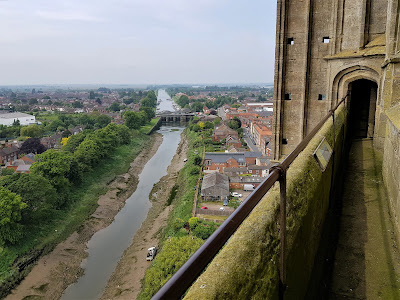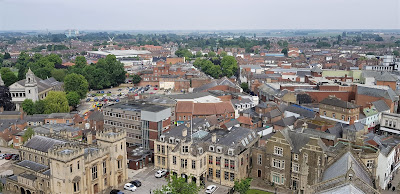And this is a post that describes a scary moment or two. Because I hate heights. On the other hand, I won't let personal fear thwart me if I really want to see something, nor a degree of physical effort.
What is the Boston Stump? Well, it's the very tall, conspicuous tower of the main church in Boston in Lincolnshire, St Botolph's. And I mean really tall, really conspicuous! You can see it from all parts of Boston. It is of course a magnet for visitors. It's far and away the main reason for visiting Boston at all, although there are certainly other sights, and I wouldn't dismiss the place as uninteresting and unattractive. It's an old town, historically very important, and there are signs aplenty that it has always been a major port and market centre. This is the town that gave its name to Boston in Massachusetts in America. St Botolph's Church is ample evidence of past wealth being poured into a very impressive medieval building project.
Boston today has unfortunately become linked with the subject of Eastern European immigration, as indeed has all of Lincolnshire. Outsiders, fed with scary media stories over a long time, might be forgiven for thinking that this is a place taken over by Polish immigrants, with the British residents marginalised and restless, voting for Brexit for xenophobic reasons. Emphatically not so. True, you can easily catch Polish being spoken in the streets, but I saw only one bilingual public notice (up the Stump: more on this later). It seemed to me that the Polish contingent had blended in rather well, and some individuals had happily settled down here, and had woven themselves into the fabric of the local community. Do not believe what journalists in search of a story push at you: the flavour of the place was still thoroughly English. As English as Lincoln itself.
But let's climb the Stump.
My visit to Boston in May was the first for many years. Indeed, I hadn't walked about the place since going there on a late-season holiday break with Mum and Dad in October 1992, staying then in the New England Hotel in the Wide Bargate. I was highly curious to see what changes had taken place in twenty-six years.
The Stump stands right by the River Witham, and one street in particular, near the station, called appropriately Tower Street, has a fine view of the Stump. Here are two misty 1992 photos of mine, and then two 2018 shots from this same street.

In the three lower shots, the river is in between where I'm standing and the Stump. Men do say 'tis called the Stump because it resembles a tree trunk that has been blasted by lightning emenating from the Heavens. A thunderbolt from the Hand of God in fact. (Not to be confused with the Hand of God that I understand gave Argentinian footballer Maradona an edge in the 1986 World Cup)
Let's walk towards the Stump and feel its presence closer up. First you cross a footbridge that wasn't there in 1992...
Then you pass between buildings down on the river's edge, one of them a pub.
A old chappie in pensioner attire - you can just see him - lurched out of the pub door and buttonholed me with Yorkshire-sounding words on these lines: 'Ee, where's bridge?' To which I rather stupidly replied 'I'm afraid I don't know - I'm only a visitor.' No wonder he gave me a sniffy look and asked somebody else. I didn't care. Before me lay Boston's finest (and tallest) building.
Let's go in. I won't overwhelm you with too many shots - see Flickr for more - but the interior really was rather impressive.
It's become customary with me to take many pictures of buildings like this. I enjoy the architecture. I also enjoy the carvings in wood and stone, the monuments, and usually (though not always) the artworks. But let's attend to the main purpose of my visit. I wanted to climb the tower and see the view. It was, unsurprisingly, £5.00 to get a ticket from the church shop. I didn't begrudge that at all. And I had fun using my phone to pay with. It's so amusing that this continues to amaze people who serve you.
The procedure was this. There were winding stairs up, and separate stairs down, one-way in each case. These were the doors.
You took with you a numbered card which you handed back when finished. It had rescue advice on the back. Here was mine.
You also signed a register.
There was a warning against climbing at all if you couldn't handle the effort needed.
There were indeed over two hundred steps - I counted 204 on the way down.
Right. Let's go up. The entrance door clicked shut behind me. Stone steps wound their way upwards. You just had to put one foot in front of another and hope that you made it. There are usually places to pause and take a breather if you need to: sedentary medieval clergy on spare diets were not necessarily fitter than modern people.
Well, it wasn't too bad. I can recall struggling with some tower and lighthouse climbs I've attempted. This one, taken steadily, didn't make me feel uncomfortable. The stone steps were in generally good repair. Nor did it become claustrophobic - spiral staircases like this tend to get narrow in their upper sections. Certainly the upper hundred steps were narrower than those below, but not as awkward as those you encounter when climbing, say, the tower of Worcester Cathedral. This said, I was glad to emerge into daylight again. Here we are. What could one see?
Oooh. A southerly view over the town centre and river! There's the footbridge over the river.
The river is tidal, and this was low tide. At high tide it fills its channel to the brim. At each corner of the tower, you bent low and passed through an archway to enjoy the view on the next of its four sides.
I looked upwards.
I wasn't by any means at the top of the tower, where the bells were, just two-thirds of the way up. But that was quite sufficient for a really great view. And high enough to induce vertigo, or at least an unpleasant sensation. Despite the safety rail, that parapet was a bit too low for my liking, and I began to feel a concern for my personal well-being that showed on my face.
But the Melfords are not ordinary mortals. I quelled my naked fear and persevered.
Oops! Got a bit too close to the rail there.
That was it. I had seen the panorama, and on a clear sunny day at that. I had my photos. A long-time wish was fulfilled, a personal challenge met, and the brave reputation of the Melfords upheld. Time to go, before the dreadful height turned me into a jelly. But I still had enough curiosity to inspect the entrance to stairs that led even higher, though locked against ordinary persons.
Ah, a bilingual notice! The first I'd seen. And not a new one. Clearly people from Poland came up here too. As English people visiting Gdansk might do. Here was the way down.
My escape route! I didn't rush it, and carefully counted the number of steps to take my mind off how tired my leg muscles felt. At length, the bottom, and the exit door.
I was the perfect visitor, and did all that they required. I now felt well justified in having some refreshment at the church café.
It was very nice. I was definitely refortified after the climb.
My visit to Boston didn't end there. I spent another hour exploring the place. Essentially, it was hardly changed. Some things had come, others had disappeared. The market place was still an impressive open area with its distinctive old-fashioned Five Lamps.
Upmarket shops I remembered from 1992, like Oldrids and Coneys, were still there. They were both worth a look. Even the New England Hotel seemed to have survived unchanged.
I got the firm impression that Boston's town centre was bucking the national trend, and thriving. It certainly had the air, spurious or not, of a busy and prosperous place, in no way dragged down by recession and an influx of foreigners. It looked cared-for and tidy. I wouldn't say it was picturesque, any more than I will say (in a forthcoming post, though not the next) that Hull is picturesque. It was busy, and commercial, but kind to the visitor. I want to return and see a bit more.
I walked back to Fiona via the old road bridge over the river, which in 1992 was the only way to cross the river on foot. The view of the Stump was just as good. Or would have been, if the tide was in!






















































